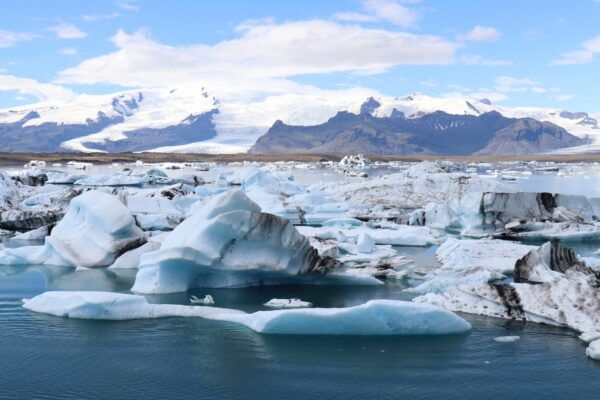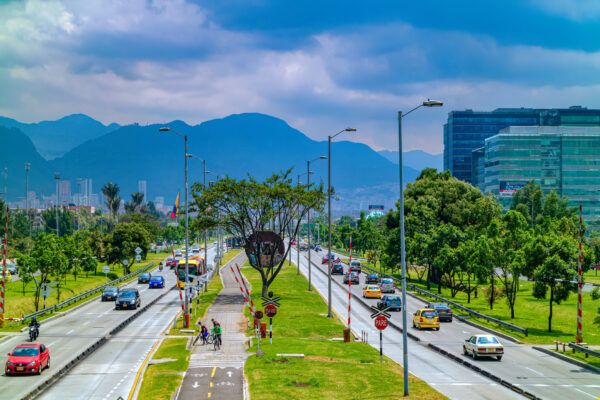The air I breathed as a child was much cleaner than my parents ever experienced in their youth, and much, much cleaner than my grandparents enjoyed. We’re breathing air that is cleaner than it has been for centuries. But it’s a success story that we rarely tell.
It’s not just emissions of SO2 that have fallen in the UK. Emissions of local air pollutants are just a fraction of what they were. Nitrous oxides are down 76% from their peak. Black carbon is down 94%, volatile organic compounds down 73% and carbon monoxide down 90%.
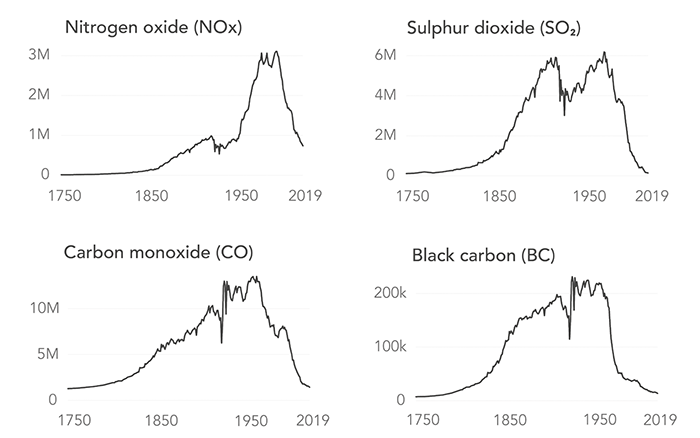
The UK is no outlier. It’s the same story across most of the world’s rich countries. Reductions in the US, Canada, France and Germany, have been just as impressive. This success is largely the result of successful environmental regulation. The UK implemented its first Clean Air Act in 1956, following London’s Great Smog. Decade by decade, these regulations were made tighter. In response, industries had to develop low-pollution technologies. We learned how to strip the sulphur out of coal-burning. We banned leaded petrol. We learned how to produce cars and trucks that emit just a fraction of the pollution they once did. The US implemented its Clean Air Act in 1970, with similarly impressive results.
Environmental action is often framed as at odds with the economy. It’s either climate action or economic growth. Pollution versus the market. This is just wrong. Countries have slashed air pollution while growing their economies at the same time. Lower pollution, better health and a stronger economy? That sounds like the perfect sales pitch to me.
It often gets worse before it gets better: air pollution is also falling in many growing economies
The path that countries follow is a predictable one. Pollution first rises as a country starts to move out of poverty. At this stage, access to energy is the priority. It burns coal, oil, gas without tight restrictions on how clean it needs to be. There are no demands for top-of-the-range power plants with anti-pollution controls, or new car engines with particle filters. Pollution levels continue to rise as more people get electricity, cars, and can afford to heat or cool their homes. The country enters an industrial boom. People have more money and life is getting better. The pollution isn’t pleasant, but the trade-off seems worth it.
But, eventually, the country reaches a tipping point in its pathway to prosperity. Once life is comfortable, our concerns turn to the environment around us. Our priorities shift, and we no longer want to tolerate dirty air. Governments have to shift too; they are forced to take action and reduce levels of air pollution. The curve of air pollution reaches its peak and starts to decline.
This journey is often called the ‘Environmental Kuznets Curve’: plot an environmental metric against income and it forms an upside-down ‘U’ (it’s low when we’re poor; it rises to reach its peak at middle incomes; then falls again as we get richer). There are lots of environmental metrics where this Kuznets Curve doesn’t hold true. But it works for air pollution, which means we can tell what stage of economic development a country is in just by drawing a curve of how polluted its air is. India, for example, is just approaching its turning point. It’s on the brink of peak pollution. China is further ahead and has now passed the peak:
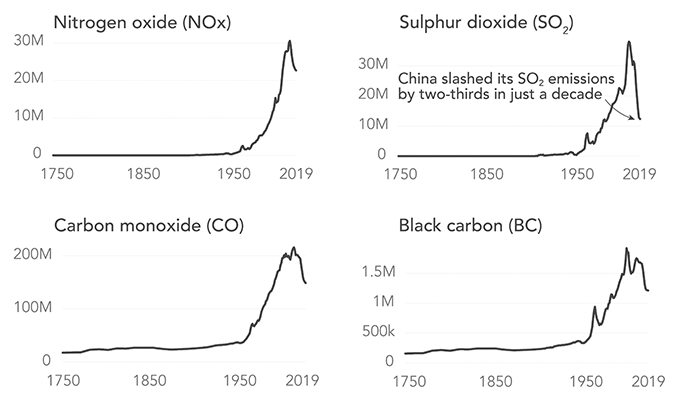
It took countries like the UK and the US two centuries to go through the rise and fall of air pollution. With new technologies, countries are going through this transition four times as quickly. Better yet, some of the poorest countries might be able to skip the curve entirely.
Millions of people die from air pollution every year
Air pollution might be falling in many countries, but it’s still one of the world’s biggest killers. It increases our risk of respiratory disease, stroke, cardiovascular disease and lung cancer.
And it’s the little particles we can barely see that are especially bad for our health. Scientists often refer to them as ‘PM2.5’ – particulate matter that is smaller than 2.5 micrometres in diameter. Almost invisible. The problem is that these tiny particles can sneak deep into our lungs and respiratory system. Visit the beach and you will find annoying bits of sand in your shoes for days. You won’t find any hidden boulders in there, but the smallest grains get into the smallest cracks. Particles in the air are no different.
In 2020, nine-year-old Ella Adoo-Kissi-Debrah became the first person in the world to have ‘air pollution’ on her death certificate. She died of asthma, and a London Coroner’s Court concluded that air pollution played a large role. This outcome is rare. Air pollution kills a lot of people, but it’s not cited as a cause of death. Instead, researchers estimate premature deaths from measurements of pollutants in the air, and our understanding of how this increases our risk of deadly diseases.
Researchers don’t agree on the exact number. But they do agree that it’s tragically high – in the order of millions. The World Health Organization estimates that air pollution kills 7 million people every year: 4.2 million from outdoor air pollution, and 3.8 million from indoor air pollution from burning wood and charcoal. The world’s other big health institute, the Institute for Health Metrics and Evaluation (IHME), gives a similar number: 6.7 million. Some scientists think this number could be even bigger: some of the most recent and widely cited studies estimate that at least 9 million people die every year from the air they breathe.
To put these numbers into context, this is similar to the death toll from smoking: around 8 million. It’s six or seven times higher than the number of people that die in road accidents: 1.3 million. Hundreds of times more than the number that die from terrorism or war each year. Air pollution is the silent killer that doesn’t get enough headlines. It doesn’t shock us like images of a flood or a hurricane, but it kills around 500 times more people a year than all ‘natural’ disasters combined, in most years.
But death rates from air pollution are falling
This is a bleak picture. But as with so many examples in this book, it is not the whole picture. While the number of deaths from air pollution is still horrifically high, the data does contain hope. We could be at the peak of the human tragedy that is air pollution. It’s possible – in fact, it’s likely – that we’re approaching ‘peak pollution deaths’. That sounds grim, but it also means that the worst is behind us.
Why do I think we’re approaching the peak? The total number of deaths from air pollution globally has been about the same for decades. The death toll hasn’t changed much despite there being many more people in the world. And, especially, older people who are at much higher risk of dying from strokes, cardiovascular disease and cancers. This means that the death rate from air pollution – or the risk for the average person – has been declining, and not just a little: death rates have halved since 1990 by some estimates.
If global population growth slows down, and air pollution continues to improve, the world will soon pass the peak of air pollution deaths. The downward slope could be much steeper than the upward one. A rollout of clean technologies could see pollution deaths plunge in a matter of decades.
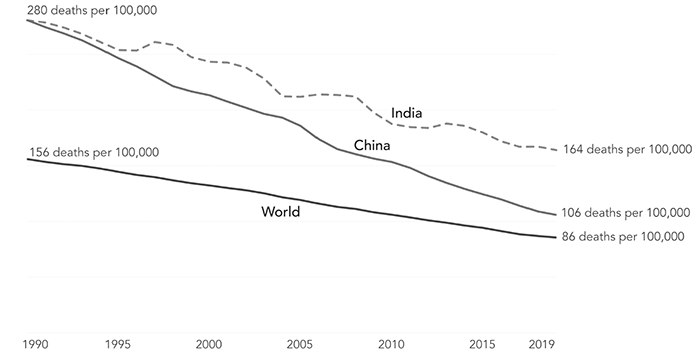
The is an excerpt from Hannah Ritchie’s book, Not the End of the World: How We Can Be the First Generation to Build a Sustainable Planet (published by Chatto & Windus, Vintage)
